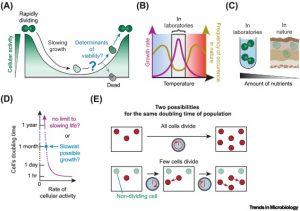Microbial life exhibits incredible adaptability, thriving in diverse and often extreme environments where conditions are far from ideal. This article explores the survival strategies of microorganisms in environments where life appears to be in slow motion or even halted altogether—places characterized by extreme cold, dryness, and nutrient scarcity (Figure 1). Such environments challenge our understanding of the limits of life and offer insights into microbial persistence, which has implications for fields ranging from astrobiology to biotechnology.

Figure 1: Microbes with slowed or suspended lives are abundant in nature, but not in laboratories, and pose questions about fundamental limits to life.
Microbial Survival in Cold Environments
Cold environments, such as polar regions, deep oceans, and high-altitude glaciers, present significant challenges to microbial life. Temperatures in these areas can drop below freezing, slowing down metabolic processes to near standstill levels. However, certain microorganisms, known as psychrophiles, have adapted to thrive in these frigid conditions.
Psychrophiles have evolved several strategies to survive in the cold. One key adaptation is the production of cold-active enzymes, which remain functional at low temperatures. These enzymes have a more flexible structure compared to their mesophilic counterparts, allowing them to catalyse biochemical reactions even in the cold. Additionally, psychrophiles produce antifreeze proteins that prevent ice crystal formation within their cells, which could otherwise be lethal.
The cellular membranes of psychrophiles are also adapted to the cold, maintaining fluidity by incorporating unsaturated fatty acids, which prevent the membrane from becoming too rigid. These adaptations enable psychrophiles to maintain cellular function and survive in environments where most life forms would perish.
Microbial Life in Dry Environments
Dry environments, such as deserts and hyper-arid regions, pose another extreme challenge for microbial survival. In these habitats, water availability is the primary limiting factor, and microorganisms must employ strategies to cope with desiccation.
Many desert microorganisms are capable of entering a state of anhydrobiosis, a dormant condition in which metabolic activities are nearly undetectable. In this state, cells lose most of their water content, which protects them from the damaging effects of dehydration. Certain bacteria and fungi produce protective molecules such as trehalose and other compatible solutes that stabilize proteins and membranes during desiccation.
Microorganisms in dry environments also exhibit remarkable abilities to rehydrate and resume metabolic activities rapidly when water becomes available. This capability allows them to take advantage of rare and brief periods of moisture, such as after rainfalls, to grow and reproduce before returning to dormancy.
Nutrient Limitation and Survival
Nutrient scarcity is another common feature of extreme environments, such as the deep ocean, subsurface soils, and the upper atmosphere. In these oligotrophic environments, microorganisms must adopt strategies to survive with minimal resources.
One such strategy is the reduction of metabolic rates to conserve energy. Many microorganisms enter a state of low metabolic activity, akin to dormancy, in response to nutrient limitation. During this state, cells focus on maintaining basic functions and repair mechanisms while waiting for more favourable conditions.
Another adaptation is the ability to utilise a wide range of organic and inorganic substrates for energy and growth. Some microorganisms possess diverse metabolic pathways that allow them to switch between different energy sources depending on availability. For instance, certain bacteria can use alternative electron acceptors, such as nitrate or sulphate, in the absence of oxygen to generate energy through anaerobic respiration.
Microbial communities in nutrient-poor environments often engage in symbiotic relationships, where different species cooperate to share resources and optimise survival. This cooperative behaviour allows them to maintain stable communities even when individual species might struggle to survive on their own.
The Role of Dormancy in Microbial Survival
Dormancy is a common survival strategy employed by microorganisms in extreme environments. In the dormant state, cells drastically reduce their metabolic activities, which allows them to endure prolonged periods of unfavourable conditions. This strategy is particularly effective in environments where extreme conditions are intermittent or seasonal.
Dormant cells can remain viable for extended periods, sometimes even for years or decades, until conditions improve. This ability is crucial for survival in environments where resources are scarce or environmental conditions fluctuate dramatically.
Dormancy also plays a role in microbial dispersal. Dormant cells, such as spores, are often more resistant to environmental stressors like UV radiation, desiccation, and temperature extremes. This resistance allows them to be transported across harsh environments, potentially colonising new habitats when conditions become favourable.
Implications for Astrobiology and Biotechnology
The study of microbial life in extreme environments has significant implications beyond understanding Earth’s biosphere. It informs the search for extraterrestrial life, particularly on planets and moons with harsh conditions similar to extreme environments on Earth. The resilience and adaptability of microorganisms suggest that life, if it exists elsewhere, could survive in seemingly inhospitable places like Mars, Europa, or Enceladus.
In biotechnology, the enzymes and other molecules produced by extremophiles have valuable applications. Cold-active enzymes, for example, are used in industrial processes that require low-temperature operations, such as in food processing and bioremediation. Understanding microbial survival strategies also aids in developing preservation techniques for food, pharmaceuticals, and biological samples.
Conclusion
Microbial life in slow and stopped lanes demonstrates the remarkable adaptability of microorganisms to extreme environments. Through strategies such as metabolic slowdown, dormancy, and specialised biochemical adaptations, these organisms not only survive but thrive in conditions that challenge the limits of life. The study of these extremophiles not only deepens our understanding of life on Earth but also expands the possibilities for life elsewhere in the universe.
Journal article: Walker, R., et al., 2024. Microbial life in slow and stopped lanes. Trends in Microbiology.
Summary by Faith Faith Oluwamakinde
References
- Feller, G., & Gerday, C. (2003). Psychrophilic enzymes: hot topics in cold adaptation. Nature Reviews Microbiology, 1(3), 200-208.
- Robinson, C. H. (2001). Cold adaptation in Arctic and Antarctic fungi. New Phytologist, 151(2), 341-353.
- Rothschild, L. J., & Mancinelli, R. L. (2001). Life in extreme environments. Nature, 409(6823), 1092-1101.
